Mathematica Eterna
Open Access
ISSN: 1314-3344
ISSN: 1314-3344
Research Article - (2019)Volume 9, Issue 1
In this paper, we are concerned with the large time behavior of weak entropy solutions to the multi-dimensional unipolar hydrodynamic model of semiconductor with insulating boundary conditions and non-zero doping profile. For any space dimension, we prove the solutions converge to the stationary solutions exponentially in time. No smallness conditions are assumed.
Large time behavior; Unipolar hydrodynamic model; Insulating boundary conditions; Non-zero doping profile
In this paper, we consider the following unipolar hydrodynamic model of semiconductor:

Where 
with being a bounded open set in  The unknowns
The unknowns represent the scaled partial density and current density of the
electrons. The unknown function E denotes the electric field, which
is generated by the Coulomb force of particles. If we introduce the
electrostatic potential φ then
represent the scaled partial density and current density of the
electrons. The unknown function E denotes the electric field, which
is generated by the Coulomb force of particles. If we introduce the
electrostatic potential φ then In this paper, we consider
the isothermal case
In this paper, we consider
the isothermal case  which is of importance in industry.
The symbols
which is of importance in industry.
The symbols  denote the Kronecker tensor product
and the divergence in. Is the doping profile, which means the
density of impurities in semiconductor materials? We suppose.
denote the Kronecker tensor product
and the divergence in. Is the doping profile, which means the
density of impurities in semiconductor materials? We suppose.

In this paper, we consider problem (1.1) with the initial conditions

And the following insulating boundary conditions

Where n is the outer unit normal vector on ∂Ω.
Now let’s recall some known results for the model (1.1). The existence and uniqueness of the subsonic steady solutions was first established by Degond- Markowich, Gamba investigated the stationary transonic solutions [1-5]. For the time dependent model, Hsiao-Yang, Luo-Natalini-Xin and Guo-Strauss proved the existence of global smooth solutions near a given steady state for different kinds of initial or initial-boundary conditions [6-14]. However, Chen proved the existence of the local generalized solutions and gave the blow up phenomenon of this equation [3]. Therefore, it is necessary to study weak solutions. The existence result of weak solutions was given in [7,15-26]. Huang and Yu proved the weak solutions converge to the stationary solutions exponentially in time when space dimension [9,25]. For more results about the unipolar model of semiconductor, we can refer to [1,8,10-12,14,16-20].
In this paper, our main goal is to prove the exponential convergence of multi-dimensional unipolar hydrodynamic model of semiconductor with insulating boundary conditions and nonzero doping profile. That is, all weak entropy solutions of problem (1.1) (1.3) (1.4) converge to the corresponding stationary system.

With an exponential decay rate, when d =1,2, he existence to smooth solution of problem (1.5) can be proved by variation method [6].
Before stating the main result, we first give the definition of weak entropy solution and some common notations.
Definition 1.1. A For everyT > 0 , the function (n,J,E)(x,t)∈(L2 (Ω×[0,T)))2d +1 is said to be a L2 weak solution of problem (1.1)(1.3)(1.4) if,
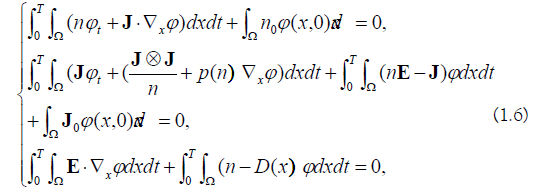

In the sense of trace. Furthermore, a weak solution of system (1.1) (1.3) (1.4) is called an entropy solution if the following entropy solution if the following entropy inequality.

Hold in the distributional sense, where (1.7) use the Einstein’s summation symbols (η, q) , is entropy flux pair satisfying.
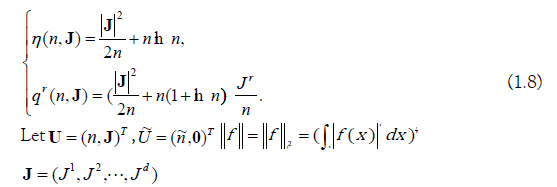
and we choose  to represent different positive
constants in different places.
to represent different positive
constants in different places.
The main result of this paper is given below.
Theorem 1.1. Suppose  is a smooth solution
of problem (1.5),
is a smooth solution
of problem (1.5),  is any
is any weak entropy
solution of problem (1.1)(1.3)(1.4). If there exist positive constants
weak entropy
solution of problem (1.1)(1.3)(1.4). If there exist positive constants  and ~( ) *,
* N ≤ n x ≤ Nsuch that,
and ~( ) *,
* N ≤ n x ≤ Nsuch that,

For any  then
then

Holds for some positive constants α and β .
From equations (1.1) and (1.5), we obtain the following system.

Satisfies in the sense of Definition 1.1.
The proof of Theorem 1.1 is completed in the following two theorem.
Theorem 2.1. Suppose (U,E)( x,t)
be a weak entropy solution of (1.1)(1.3)(1.4) in the time interval  is a smooth solution of problem (1.5), If (1.9) and
(1.10) satisfy for any
is a smooth solution of problem (1.5), If (1.9) and
(1.10) satisfy for any  and t > 0 , then,
and t > 0 , then,

Holds for some positive constants C1
Proof: Using Einstein’s summation convention, we can rewrite the first d +1
equations of (1.1) as a hyperbolic system of conservation laws.

Where,


From (1,7), we obtain

With the energy production

Let,

Where,

From(1.5) and (2.6) - (2.8), we obtain
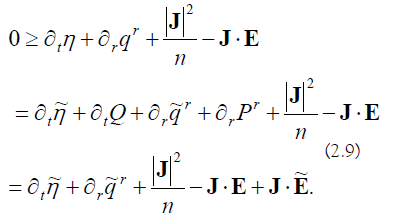
Integrating the last equation in (2.9) over Ω and using the boundary condition (1.4), we get

On the other hand, after integrating by parts and using the boundary condition (1.4) for several times, we obtain

Combining (2.10) with (2.11), we obtain

Moreover, we notice that 
is the quadratic remainder of the Taylor expansion of the convex
function n lnn around  . Therefore, using (1.9) and
(1.10), we obtain there exist positive constants C2 and C3 such
that,
. Therefore, using (1.9) and
(1.10), we obtain there exist positive constants C2 and C3 such
that,

We finish the proof of Theorem 2.1.
Theorem 2.2. Under the same assumptions as in Theorem 2.1, we further have the exponential decay rate, that is,

For some positive constants α and β .
Proof: To get the exponential decay rate, we would like to use the Gronwall inequality. To do this we define,

Where μ
is a real number which will be determined later? In terms of (2.1)2 and the boundary condition (1.4), we get,

We calculate the right side of (2.14) item by item. Firstly, using Young’s inequality, we have,

Which gives,

We also have,
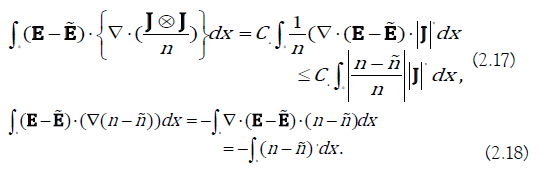
Notice
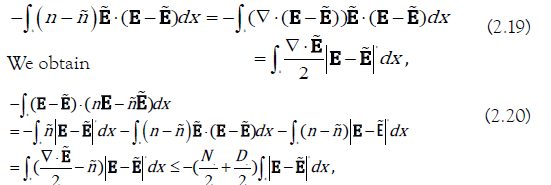
Where we have used (1.5)2 and the fact that

From the above analysis (2.14)-(2.20) and (2.11) (2.12), we deduce

Which

As the proof in [2], we can choose μ
small enough such that W and Y are positive definite quadratic forms. So there exist positive constants KW and KY such that,

The estimate (2.21) turns into

From Gronwall inequality we get Theorem 2.2, with
By Theorem 2.2 we can easily deduce Theorem 1.1.
Citation: Qiu L, Cheng Y, Guo R (2019) Large Time Behavior of Multi-dimensional Unipolar Hydro-dynamic Model of Semiconductor. Mathematica Eterna 9: 102. doi: 10.35248/1314-3344.19.09.102
Received: 03-May-2019 Accepted: 10-Oct-2019 Published: 22-Oct-2019
Copyright: ©2019 Qiu L, et al. This is an open-access article distributed under the terms of the Creative Commons Attribution License, which permits unrestricted use, distribution, and reproduction in any medium, provided the original author and source are credited.